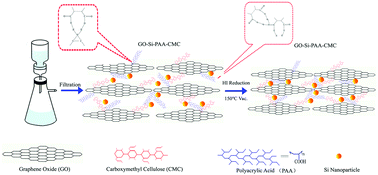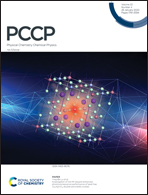Bioinspired hierarchical cross-linked graphene–silicon nanofilms via synergistic interfacial interactions as integrated negative electrodes for high-performance lithium storage†
Abstract
Inspired by the intrinsic relationship between sophisticated interfacial architecture and the outstanding mechanical performance of natural nacre, a flexible, large-area and robust bioinspired reduced graphene oxide–silicon–carboxymethyl cellulose–polyacrylic acid (rGO–Si–CMC–PAA) nanocomposite film with a hierarchically laminated structure was prepared via a vacuum-assisted filtration self-assembly process and a thermal condensation reaction. The as-prepared rGO–Si–CMC–PAA films exhibited a typical orderly layered structure with a thickness of about 40 μm, and Si nanoparticles were uniformly distributed and embedded throughout the continuous graphene network. As binder-free, integrated anodes for lithium-ion batteries (LIBs), the free-standing rGO–Si–CMC–PAA films exhibited appealing electrochemical lithium storage properties with a high reversible capacity (2153.49 mA h g−1), long-term cycling stability with 63% capacity retention even after 800 cycles at 420 mA g−1, and a superior rate capability. Therefore, the bioinspired strategy of synergistic interfacial interactions of hydrogen and covalent bonding also provides a promising avenue for constructing integrated high-performance graphene-based nanocomposite films in the future.



 Please wait while we load your content...
Please wait while we load your content...